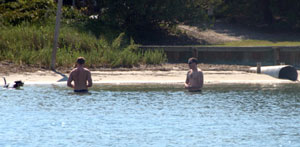MOREHEAD CITY — North Carolina would likely have to cut by more than half the number of coastal swimming beaches that it routinely tests for contamination if the U.S. Environmental Protection Agency follows through with a plan to eliminate federal grants for the monitoring.
Citing the “difficult financial climate,” the EPA said in its budget request last week that it would do away with the $10 million in grants it gives each year to state and local agencies in coastal and Great Lakes states and U.S. territories to test for tainted water at swimming beaches.
Supporter Spotlight
“While beach monitoring continues to be important to protect human health and especially sensitive individuals,” the EPA said in an emailed statement published in the Los Angeles Times, “states and local governments now have the technical expertise and procedures to continue beach monitoring without federal support.”
But do they have the money to continue the programs at the same level?
North Carolina certainly doesn’t, noted J.D. Potts, who heads the monitoring program for the N.C. Shellfish Sanitation and Recreation Water Quality Section in Morehead City. The program is part of the N.C. Division of Marine Fisheries.
“If these cuts go through, it will have a huge impact on our program,” he said.
 The state routinely monitors popular swimming beaches for bacterial contamination. |
The state has gotten about $300,000 a year from the EPA for the testing program, Potts said. To put that into some perspective, Florida and California typically get about $500,000 a year, the most of any state or U.S. territory. The yearly grant to North Carolina pays the entire salaries of three staff members, Potts explained, and portions of the salaries of three others. A quarter of Potts’ salary comes from the grant, which also buys equipment and lab supplies.
Supporter Spotlight
Started in 1996, the monitoring program tests for bacterial contamination at popular swimming areas along the coast and posts warning signs when bacteria levels exceed the standard considered safe for bodily contact. Swimming in polluted water exposes people to pathogens that can cause gastrointestinal illness, diarrhea, vomiting, skin rashes and ear, eye and staph infections.
As in other states, the N.C. program expanded after Congress passed the BEACH act in 2000. The law created the EPA grant program, which has paid $111 million to states and U.S territories for water-quality testing at swimming beaches. In the dozen years since the law was passed, the number of monitored beaches has more than tripled to more than 3,600 in 2010, the EPA announced last month.
Potts and his staff currently test 240 swimming areas in the ocean, sounds, bays and rivers. Dare County, with 57 sites; Carteret County, with 56; and Brunswick County with 39 have the most testing sites.
The 100 most popular swimming areas, which include all testing sites along the ocean and the most-used sites in the sounds and rivers, are tested weekly during the spring and summer. The other sites are tested at least twice a month. Testing is less frequent at all sites during other times of the year.
“If these cuts go through, we would be forced to cut back to doing the top 100 sites,” Potts said. “We may have to cut back on some of them as well.”
It’s unlikely that the N.C. General Assembly will increase state funding to make up for the cut, Potts said. “The money’s just not there,” he acknowledged.
EPA included the cut in its budget request. Already some states and environmental groups are pressing the agency to restore the money.
“I’m sure this budget will go through several iterations,” Potts said. “I’m hoping and praying it doesn’t end up like this. This is a public health program. If they want to save money, it seems they could cut other areas and not public health.”







